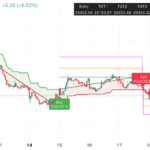Cryptocurrency trading is booming — but for many beginners, diving into the world of Bitcoin, Ethereum, and altcoins can feel like stepping into a whirlwind of jargon, risk, and complex platforms. Don’t worry — this guide is built to simplify it all.
Whether you’re hoping to invest long-term or try your hand at day trading, we’ve broken down everything you need to know to get started with confidence.
What is Cryptocurrency Trading?
Cryptocurrency trading involves buying, selling, or exchanging digital currencies via online platforms. Similar to stock trading, the goal is to buy low and sell high — but with a few key differences:
- 24/7 Market: Unlike stock markets, crypto trades never sleep.
- Volatility: Cryptocurrencies often see significant price swings in short periods.
- Decentralized System: Most cryptocurrencies are not controlled by any central authority.
Real-Life Example:
Sarah, a software engineer from Austin, Texas, began trading Bitcoin with just $200. After studying market trends for a few weeks and using stop-loss orders, she grew her portfolio to $2,000 within six months — a tenfold return that sparked her passion for crypto investing.
How Does Crypto Trading Work?
Crypto trading works through exchanges like Coinbase, Binance, and Kraken. You can trade cryptocurrency pairs (e.g., BTC/USD) or swap one coin for another (e.g., ETH to ADA).
Types of Crypto Trading
1. Spot Trading
- Buy and sell assets for immediate delivery.
2. Margin Trading
- Borrow funds to amplify gains (and risks).
3. Futures & Derivatives
- Speculate on future price movements without owning the asset.
4. Automated Trading
- Use bots or algorithms to place trades on your behalf.
Top Platforms for Beginners
| Platform | Pros | Cons |
|---|---|---|
| Coinbase | Beginner-friendly, secure, U.S. regulated | High fees |
| Binance | Low fees, wide range of coins | Complex for beginners |
| Kraken | Secure, good customer service | Fewer coins than Binance |
Pro Tip:
Start with a demo or paper trading account. Platforms like TradingView or eToro offer this, helping you practice without using real money.
Setting Up Your First Crypto Trade
Step-by-Step Guide:
- Choose a Secure Exchange: Stick to well-known, regulated platforms.
- Create an Account: Use strong passwords and enable two-factor authentication.
- Verify Your Identity: KYC (Know Your Customer) is required on most exchanges.
- Deposit Funds: Link your bank account or use a debit card.
- Place Your Order: Choose market (instant) or limit (target price) orders.
- Store Your Crypto Safely: Consider transferring to a hardware wallet like Ledger or Trezor.
Security Tip:
Never store large amounts on exchanges. Always move your assets to a personal wallet for long-term holding.
Common Crypto Trading Strategies
1. HODLing (Hold On for Dear Life)
Ideal for long-term believers in crypto. Buy and hold despite market dips.
2. Day Trading
Buy and sell within the same day to take advantage of volatility.
3. Swing Trading
Trade based on medium-term trends, holding assets for days or weeks.
4. Scalping
Make many small trades for quick gains — great with bots but risky for beginners.
Understanding Charts and Indicators
Learning technical analysis is key to becoming a successful trader.
Essential Indicators:
- Moving Averages (MA): Smooth out price trends over time.
- Relative Strength Index (RSI): Measures overbought or oversold conditions.
- MACD: Shows momentum and trend direction.
- Volume: Confirms the strength of a price movement.
Use tools like TradingView to access these indicators easily.
Managing Risk in Crypto Trading
Crypto is high risk. Follow these golden rules:
1. Only Invest What You Can Afford to Lose
Never trade your rent money.
2. Use Stop-Loss Orders
These automatically sell your assets to limit losses.
3. Diversify Your Portfolio
Don’t put all your funds in one coin. Mix Bitcoin, Ethereum, and stablecoins.
4. Stay Updated
Follow trusted news sources like CoinDesk, CoinTelegraph, and on-chain data analytics like Glassnode.
Tax Implications of Crypto Trading
Yes, you have to pay taxes! In the U.S., the IRS considers crypto as property.
- Short-term capital gains: Taxed as ordinary income if held under a year.
- Long-term gains: Lower tax rates apply for holdings over a year.
Track all transactions using tools like Koinly or CoinTracker.
Common Mistakes Beginners Make
- Chasing Hype: Avoid meme coins just because they’re trending.
- Overtrading: Quality beats quantity.
- Ignoring Fees: Small fees add up fast.
- Falling for Scams: Be wary of Telegram and WhatsApp investment groups promising 10x returns.
Real-World Example:
Jake lost $5,000 by clicking on a fake “Binance login” link he received in an email. Always double-check URLs and use browser bookmarks.
Recommended Learning Resources
- Books: “The Bitcoin Standard” by Saifedean Ammous
- Courses: Udemy’s Cryptocurrency Trading Mastery Course
- YouTube Channels: Coin Bureau, DataDash, Altcoin Daily
- News: CoinDesk, Decrypt
Future of Cryptocurrency Trading
The landscape is rapidly evolving:
- Regulation: Expect more government oversight.
- Institutional Adoption: More Wall Street firms are entering.
- DeFi and DEXs: Decentralized finance is making peer-to-peer trading mainstream.
- AI and Bots: Algorithmic trading will continue to rise.
Expert Insight:
“Crypto is where the internet was in the 90s. We’re still early. Don’t rush. Focus on learning.” — Michael Saylor, Executive Chairman, MicroStrategy
Final Thoughts: Should You Start Trading Crypto?
If you’re eager to learn, comfortable with risk, and stay disciplined, crypto trading can be both exciting and profitable. But remember: education comes before investment.
Start slow, track your trades, and never stop learning. The market may be volatile, but knowledge gives you the edge.
Featured Snippet Summary:
Crypto trading is the process of buying and selling digital currencies like Bitcoin and Ethereum on exchanges. Beginners should start by choosing a secure platform, learning basic strategies like HODLing or swing trading, and using tools like RSI and MACD for analysis. Always manage risk with stop-losses and diversified portfolios.
LSI Keywords:
- Bitcoin trading basics
- Cryptocurrency for beginners
- How to trade crypto
- Crypto exchanges
- Technical analysis for crypto
- Best crypto trading platforms
- Safe crypto investing
- Learn crypto trading
Disclaimer: This article is for informational purposes only and does not constitute financial advice. Always consult a licensed financial advisor before making investment decisions.



